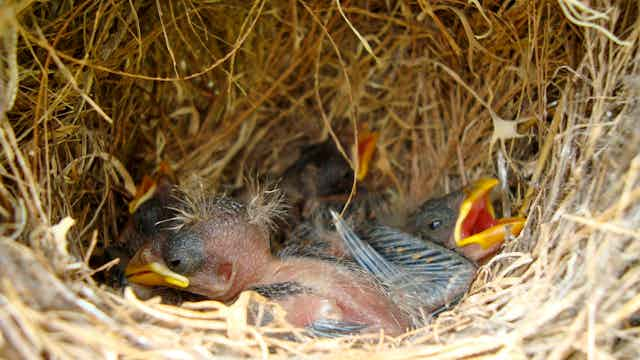When a bird species is threatened by nest parasites, you might think the logical next step is to fumigate – unsurprisingly, though, physically spraying nests (as you might spray an infested house) is disruptive, not to mention dangerous to the birds.
But a group of researchers have successfully fumigated nests of Darwin’s finches on the Galapagos Islands without disrupting the birds’ natural nesting habits. In fact, they used the birds’ nest-building skills to self-fumigate with cotton balls treated with a mild delouser, as reported in Cell Biology this week.
Despite being relatively drab in appearance, Darwin’s finches have been described as the “crown jewels of ornithology” owing to their rapid and observable evolution in the wild.

After observing different species of the birds, Charles Darwin wrote in The Voyage of the Beagle:
One might really fancy that from an original paucity of birds in this archipelago, one species had been taken and modified for different ends.
He theorised that one “immigrant” bird species must have flown over from the mainland and settled in areas with varying ecological conditions, and that natural selection would probably favour “different varieties in the different islands”.
Survival of the fittest
Darwin’s finches continue to experience intense natural selection – but recently this selection has come from an introduced fly called Philornis downsi. This parasite is altering the appearance of Darwin’s finches and threatening their survival.
P. downsi is the only ectoparasite that causes measurable fitness costs (such as slower growth, deformation and mortality) in Darwin’s finches.

Feather mites are common in Darwin’s finches but are not known to cause fitness costs. Blood parasites have not been detected and intestinal protozoan parasites are rare. Thus, Darwin’s finch hosts are considered naïve, as they have had little (known) exposure to pathogens in general.
This all changed with the arrival of P. downsi, which is known from collections on the Galapagos Islands in 1964 but was first discovered in Darwin’s finch nests in 1997.
The fly’s name (phil=loves; ornis=birds) paints a one-sided picture of affinity: fly larvae consume the blood and tissue of nestling birds, leaving Darwin’s finches dead or deformed.
Over the past decade, researchers have made significant advances in understanding the biology of this new host-parasite association.
Each female fly mates with an average of around two males and one to six females each lay an average of five eggs per Darwin’s finch nest. Female P. downsi flies generally carry around 60 eggs, so the female only lays a portion of the available clutch per host nest.
The P. downsi eggs hatch into larvae after the chicks hatch. From in-nest video recordings, we know that Darwin’s finch nestlings are literally being eaten alive by the fly larvae.
The first developmental stage (or “instar”) of the larvae feed on the inside of the nestling beak. The second and third instar larvae live in the nest base from where they feed externally on the finch nestlings.
The initial phase of parasitism inside the beak often leads to beak malformation in surviving adult finches, though most nestlings die in the nest.
Behavioural changes
Darwin’s finches are renowned for their diverse feeding behaviours. Now we are witnessing an increasing breadth in anti-parasite behaviours.
There is video evidence that Darwin’s finch parents and chicks preen to extract larvae from nares and the nest base, consume encountered larvae in the nest, and that siblings compete to avoid being at the bottom of the nestling pile and hence in close contact with larvae that reside in the nest base.

Nesting density also correlates with parasite intensity: Darwin’s finch nests with many close neighbours had more P. downsi parasites.
This latest study offers a new perspective for the study of anti-parasite behaviour in nesting Darwin’s finches, and the outcomes of the study provide an exciting approach for hands-on conservation management.
The study shows that Darwin’s finches incorporated pyrethrum-treated cotton into their nest base during nest construction, which lowered parasite intensity during the nesting phase and increased fledging success.
Identifying host behavioural patterns that can be harnessed for conservation outcomes is an exciting new research direction. The conservation behaviour framework identifies key linkages between behaviour and conservation biology derived from three basic themes:
- anthropogenic impacts on behaviour that impact biodiversity
- behaviour-based management
- behavioural indicators to other processes of conservation concern.
Who knows which species we can help next with similar techniques?

